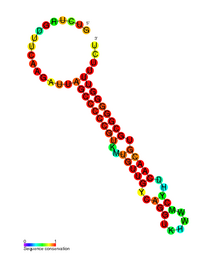LdrD-RdlD toxin-antitoxin system
| rdlD | |
|---|---|
 Conserved secondary structure of rdlD RNA. | |
| Identifiers | |
| Symbol | rdlD |
| Rfam | RF01813 |
| Other data | |
| RNA type | Gene; antisense; |
| Domain(s) | Enterobacteriaceae |
| PDB structures | PDBe |
| LdrD Type I toxin-antitoxin system | |||||||||
|---|---|---|---|---|---|---|---|---|---|
| Identifiers | |||||||||
| Symbol | Ldr_toxin | ||||||||
| Pfam | PF13940 | ||||||||
| OPM superfamily | 469 | ||||||||
| OPM protein | 5lbj | ||||||||
| Membranome | 636 | ||||||||
| |||||||||
RdlD RNA (regulator detected in LDR-D) is a family of small non-coding RNAs which repress the protein LdrD in a type I toxin-antitoxin system. It was discovered in Escherichia coli strain K-12 in a long direct repeat (LDR) named LDR-D. This locus encodes two products: a 35 amino acid peptide toxin (ldrD) and a 60 nucleotide RNA antitoxin.[1] The 374nt toxin mRNA has a half-life of around 30 minutes while rdlD RNA has a half-life of only 2 minutes. This is in keeping with other type I toxin-antitoxin systems.[1][2]
Northern blots showed that ldrD and rdlD are both transcribed and primer extension analysis showed the rdlD transcript is not translated.
Homologues exist in related Enterobacteriaceae such as Salmonella enterica and Shigella boydii. The Ldr peptide genes that have been discovered are thought to have evolved from a common ancestor.[1]
LDR sequences[edit]
Four long direct repeat (LDR) sequences were identified during genetic sequencing of a 718kb segment of the E. coli genome.[3] One of these, LDR-D was studied further in order to determine the physiological function of these regions. The genes encoded by the other three LDRs, ldrA, ldrB and ldrC were confirmed to have the same activity as ldrD.[1]
Physiological effects of LdrD[edit]
The LdrD protein causes growth inhibition, loss of cell viability, nucleoid condensation and alteration in purine metabolism when overexpressed. Once growth arrest has been achieved, it is irreversible. Another potential effect of elevated LdrD could be reduced levels of cAMP in the cell.[1] It inhibits both translation and transcription, which contributes significantly to reducing the cell's viability.[4]
Suspected mechanism of inhibition[edit]
The precise mechanism by which RdlD inhibits LdrD is unknown, however it has been shown that RdlD seems to regulate LdrD expression at the post-transcriptional level. The RdlD antisense RNA does not overlap with the translational initiation region of ldrD, as is common with Type 1 toxin-antitoxin systems.[1]
See also[edit]
References[edit]
- ^ a b c d e f Kawano M, Oshima T, Kasai H, Mori H (July 2002). "Molecular characterization of long direct repeat (LDR) sequences expressing a stable mRNA encoding for a 35-amino-acid cell-killing peptide and a cis-encoded small antisense RNA in Escherichia coli". Mol. Microbiol. 45 (2): 333–349. doi:10.1046/j.1365-2958.2002.03042.x. PMID 12123448.
- ^ Fozo EM, Hemm MR, Storz G (December 2008). "Small toxic proteins and the antisense RNAs that repress them". Microbiol. Mol. Biol. Rev. 72 (4): 579–589, Table of Contents. doi:10.1128/MMBR.00025-08. PMC 2593563. PMID 19052321.
- ^ Oshima T, Aiba H, Baba T, et al. (June 1996). "A 718-kb DNA sequence of the Escherichia coli K-12 genome corresponding to the 12.7–28.0 min region on the linkage map". DNA Res. 3 (3): 137–155. doi:10.1093/dnares/3.3.137. PMID 8905232.
- ^ Spurio R, Dürrenberger M, Falconi M, La Teana A, Pon CL, Gualerzi CO (January 1992). "Lethal overproduction of the Escherichia coli nucleoid protein H-NS: ultramicroscopic and molecular autopsy". Mol. Gen. Genet. 231 (2): 201–211. doi:10.1007/BF00279792. PMID 1310520. S2CID 22146869.
Further reading[edit]
- Van Melderen L, Saavedra De Bast M (March 2009). "Bacterial toxin-antitoxin systems: more than selfish entities?". PLOS Genet. 5 (3): e1000437. doi:10.1371/journal.pgen.1000437. PMC 2654758. PMID 19325885.
- Fozo EM, Makarova KS, Shabalina SA, Yutin N, Koonin EV, Storz G (June 2010). "Abundance of type I toxin-antitoxin systems in bacteria: searches for new candidates and discovery of novel families". Nucleic Acids Res. 38 (11): 3743–3759. doi:10.1093/nar/gkq054. PMC 2887945. PMID 20156992.
- Fozo EM, Hemm MR, Storz G (December 2008). "Small toxic proteins and the antisense RNAs that repress them". Microbiol. Mol. Biol. Rev. 72 (4): 579–589, Table of Contents. doi:10.1128/MMBR.00025-08. PMC 2593563. PMID 19052321.
